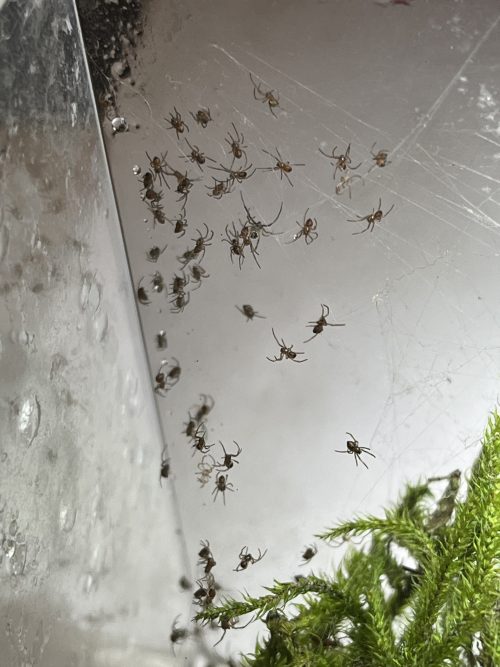I finally got away this afternoon to check on the spiders in the lab, and behold…one of the black widow egg sacs has popped!
Close-up of a Latrodectus mactans spiderling:
At this age, they aren’t noticeably black, more of a reddish orange.
I was struggling to isolate the babies. What made it hard is that a) half of them looked up and saw freedom and rushed to disperse into the general environment of the science building, and b) the other half saw danger in that guy with the paintbrush trying to scoop them up and dived down into mama’s dense tangle of silk. I compromised and spent an hour plucking ballooning spiders out of the air, and left the rest where they were hiding. I’ll be back tomorrow to see if I can catch ’em all — black widow silk is tough and hard to break through.
Also, funny thing — when I left last week, I had 5 egg sacs, then when I got back, one had hatched, but I still had 5 egg sacs. I may have stumbled unto an algorithm for infinite spiders.




Wow, just….Wow!
I think that was the plot of a French horror film I watched a few months ago. How long until the spiderlings’ bite can pierce human skin?
We all gonna die!
Good. Raise a great spider army and go mad with power!
This is why you should raise and study raccoons. You can train them to rob banks. They have hands and they already have the masks. And what court is going to convict a raccoon.
Aristotle was right!
Spontaneous Generation is true!
All Hail Our Spider Masters!
prairieslug @4
Herding cats is the cliche, but with twice as many legs, extra modes of movement, no reliable methods with which to communicate and issue commands, and no history of domestication, well…
An algorithm for infinite spiders:
1) Provide conditions for the creation of egg sacs.
2) Provide an unlimited (as far as they know) food source.
3) Protect from predation.
Yeah, I think you’ve got it.